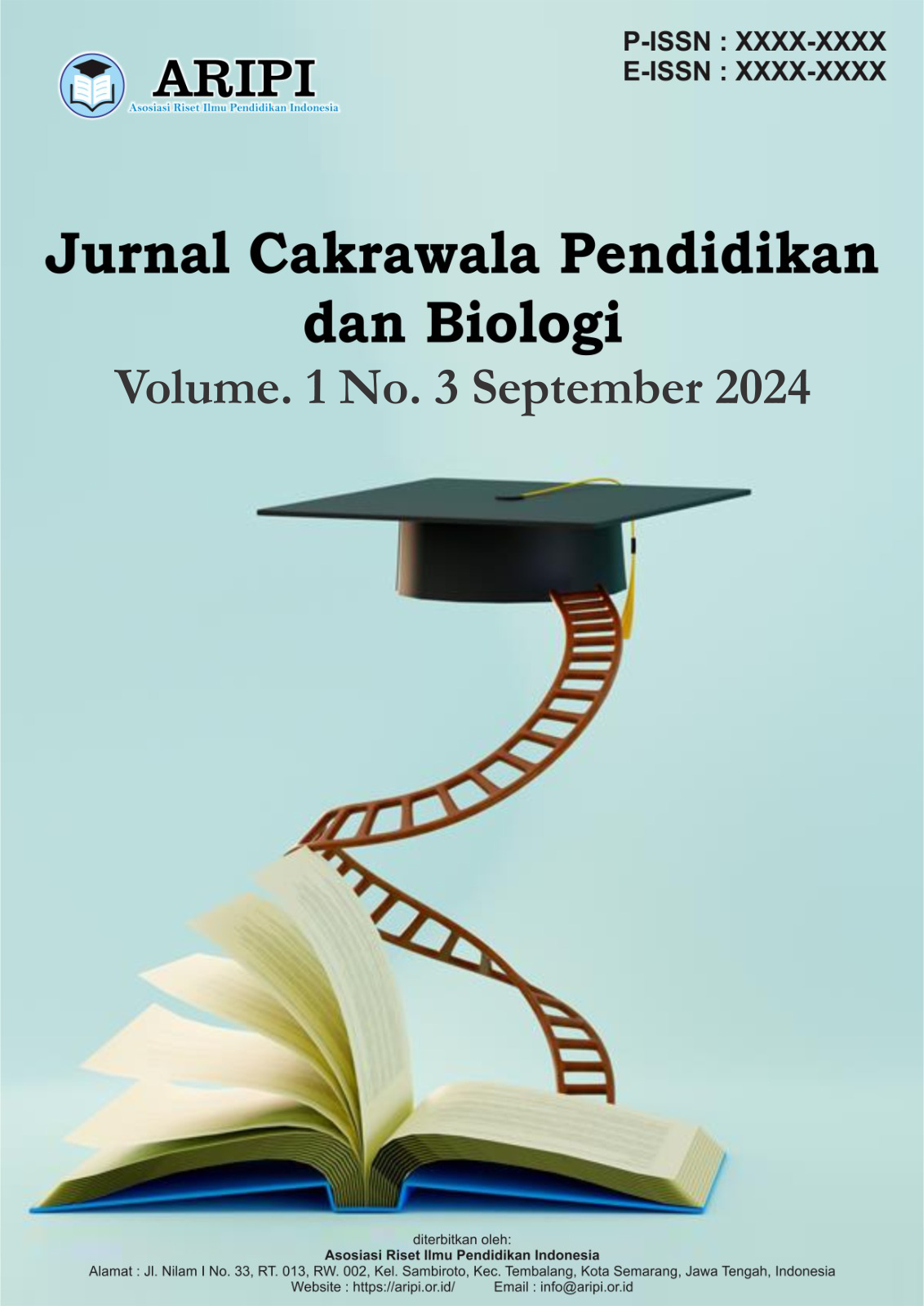Pengembangan Virtual Laboratory pada Materi Inovasi Teknologi Biologi untuk Meningkatkan Pemahaman Konsep Siswa Kelas X SMA
DOI:
https://doi.org/10.61132/jucapenbi.v2i1.255Keywords:
Virtual Laboratory, Feasibility, Effectiveness, BiotechnologyAbstract
This study aims to determine the feasibility and impact of virtual laboratories in learning the material of innovation in biological technology (biotechnology) for high school students in grade X. The feasibility assessment was carried out by three expert validators using a questionnaire instrument that measured aspects of material, media, and language and based on readability tests by teachers and students. The results of the study showed that the percentage of validity of the Virtual Laboratory from material experts was 95%, media experts 83%, language experts 90% with the third category being "Very Feasible". The results of the readability test from teachers obtained a percentage of 96% while the results of the readability test from students obtained a percentage of 99%. These results indicate that the Virtual Laboratory is Feasible and Practical to be used for biology learning, especially biotechnology material. The results of the teacher response test on the use of Virtual Laboratory showed a percentage of 95% while the results of the student response test were 75%. The results of the T test showed that Virtual Laboratory had a significant effect on students' conceptual understanding with a significance of 0.001. These results indicate that Virtual Laboratory is effective in improving students' conceptual understanding, especially in biotechnology material.
References
Adrianto Hebert, Ulinniam, Purwanti Eny Wahyuning, Yusal Muh. Sri, Widyastuti Dyah Ayu, Sutrisno Eko, … Chrisnawati Lili. (2021). 345860-Bioteknologi-269Adb13.
Agus Dellon Praditya, P., Komang Sudarma, I., Pudjawan, K., & Teknologi Pendidikan, J. (2019). Pengembangan Multimedia Pembelajaran Dengan Evaluasi Instructional Game Matematika Siswa Kelas Vii Smplb-B Negeri 1 Buleleng. Jurnal EDUTECH Universitas Pendidikan Ganesha, 6(1), 66–76.
Asep, H., Susanto, R., & Wahyudi, S. (2023). Praktikum Biologi: Meningkatkan Keterampilan dan Motivasi Siswa. Jurnal Inovasi Pendidikan, 15(1), 70-82.
Bonde, M. T., Makransky, G., Wandall, J., Larsen, M. V., Morsing, M., Jarmer, H., & Sommer, M. O. A. (2014). Improving biotech education through gamified laboratory simulations. Nature Biotechnology, 32(7), 694–697. https://doi.org/10.1038/nbt.2955
Cox, M. M., & Nelson, D. L. (2000). Fifth Edition CHAPTER 19 Oxidative Phosphorylation. https://doi.org/10.1007/978-3-662-08289-8
Dimyati, M., & Mudjiono. (2023). Mengoptimalkan Akses Pendidikan melalui Laboratorium Virtual di Daerah Terpencil. Jakarta
Freeman, S., Eddy, S. L., McDonough, M., Smith, M. K., Okoroafor, N., Jordt, H., & Wenderoth, M. P. (2014). Active learning increases student performance in science, engineering, and mathematics. Proceedings of the National Academy of Sciences of the United States of America, 111(23), 8410–8415. https://doi.org/10.1073/pnas.1319030111
Hartini, H., Narulita, E., & Iqbal, M. (2019). Pengembangan Virtual Laboratory pada topik kultur jaringan tumbuhan untuk meningkatkan hasil belajar siswa. JIPVA (Jurnal Pendidikan IPA Veteran), 3(1), 1. https://doi.org/10.31331/jipva.v3i1.658
Ismail, I., Permanasari, A., & Setiawan, W. (2016). Stem virtual lab: An alternative practical media to enhance student’s scientific literacy. Jurnal Pendidikan IPA Indonesia, 5(2), 239–246. https://doi.org/10.15294/jpii.v5i2.5492
Kesehatan, K. (2023). Dokumen Evaluasi Kinerja Pegawai Periode : Triwulan Ii. 2023.
Kuo, Y.-C., Walker, A. E., & Schroder, K. E. (2020). Interactions between online and face-to-face components in blended learning environments: Examining the effect of interaction types on student engagement and learning outcomes. Computers & Education, 146, 103766
Maksum, A., & Fitria, H. (2021). Transformasi dan Digitalisasi Pendidikan di Masa Pandemi. Seminar Nasional Pendidikan Program Pascasarjana Universitas PGRI Palembang , 121–127.
Ma, J., & Liu, Y. (2020). Enhancing understanding of genetic engineering techniques through 2D models and detailed visualizations. Journal of Science Education and Technology, 29(4), 456-467
Nurfadhillah, A., Mulyani, M., & Rizki, S. (2021). Virtual Laboratory sebagai media pembelajaran: Alat bantu guru untuk memperluas pemahaman siswa. Jurnal Teknologi Pendidikan, 14(1), 34-47
Rahmadani, W., Harahap, F., & Gultom, T. (2017). Analisis Faktor Kesulitan Belajar Biologi Siswa Materi Bioteknologi di SMA Negeri Se-Kota Medan. Jurnal Pendidikan Biologi, 6(2), 279–285. https://doi.org/10.24114/jpb.v6i2.6546
Rasya. (2023). Manfaat laboratorium virtual dalam pembelajaran: Interaktivitas dan fleksibilitas dalam proses eksperimen. Jurnal Pendidikan dan Teknologi, 15(1), 78-89
Rudianto, E., Yuliana, S., Muflihatul, S. K., & Amalia, N. L. (2021). Laboratorium Bioteknologi Berbasis Virtual Sebagai Edukasi KepadaSiswa SMAN 1 Turen Dalam Upaya Penanganan Pandemi Covid-19. Prosiding Seminar Nasional Pengabdian Kepada Masyarakat (SINAPMAS) , (September), 163–174.
Smith, A., & Johnson, B. (2021). The Impact of Technology on Modern Education. Education Technology Journal, 15(2), 45-60
Sugiyono. (2015). Metode Penelitian dan Pengembangan R&D.
Zhu, X., & Liu, S. (2019). The impact of virtual laboratories on students’ understanding of biotechnology concepts: Interactive simulations for complex processes. Journal of Educational Technology & Society, 22(3), 123-135.
Downloads
Published
How to Cite
Issue
Section
License
Copyright (c) 2025 Jurnal Cakrawala Pendidikan dan Biologi

This work is licensed under a Creative Commons Attribution-ShareAlike 4.0 International License.






